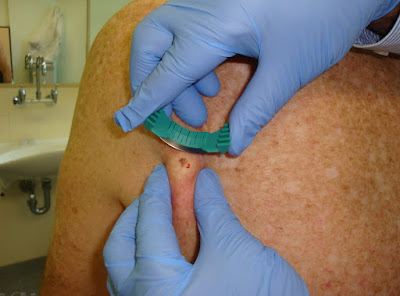Often when you look at a path slide an obvious feature catches your eye. It is quite useful to have a list of differential diagnoses for these features. You should still systematically examine a slide in case a less obvious feature is actually present and is of even more importance!I also like to look at a slide and immediately state whether I think this is an Epidermal or a Dermal histological pattern. I then assign a couple of mnemonics as followsIf Epidermal then the diagnosis will be one of the Red Scaly or Skin Coloured scaly diagnoses and the mnemonic will be the PMsPET a little cat called PETALIf dermal then the mnemonic will be CUL DVA EVIE If pustules obvious us II and if vesicles or blisters use ICI (See explanation for these mnemonics below.)So look at the slide, decide whether Epidermal or Dermal or Both, Go through the diseases in the relevant mnemonic and then look for Specific histological features or clues to decide on the likeliest diagnosis. If you need more information on a histopath feature look at Dermpath Diagnosis If you want to see clinical pictures of the skin diseases go to GlobalSkin Atlas. If you need more information on the mnemonics look at Differential DiagnosisEpidermis.Parakeratosis
Parakeratotic column
Alternating Ortho and Parakeratosis
Abscent stratum corneum
Neutrophils in the stratum corneum
Collections of cells in the epidermis
Thickened epidermis
Thinned epidermis
Thickened basement membrane
Epidermis with Atypical keratinocytes
Dyskeratotic cells
Pale cells in the epidermis
Epidermotropism
Basal layer damage
Pagetoid spread of cells or nests
Follicular pathology
Dermis Grenz zone
Papillary oedema
Material laid down
Black staining
Pink staining
Blue staining
Clear cells
Clear spaces between cells
Indian filing of cells between collagen
Cells with anything within them
Papillary microabscesses
Flame figures in the dermis
Busy dermis
Giant cells
Ectopic tissue
Lichenoid infiltrate
Perivascular infiltrate
Mid dermal infiltrate
Desmoplasia
Involvement of fat
TumoursBlue cells in dermis
Spindled cells
Granular cells
Clear cells
Balloon cells
Excess eccrine ducts
Excess Sebaceous glands
Excess vascular spaces
Keratin cysts in the dermis
Indian filing
Atypical cells with prominent nucleoli
Adapted from Dermatopathology - Diagnosis by first impression. Christine J Ko and Ronald Barr Wiley-Blackwell
The conventional approach to teaching the pathological diagnosis of inflammatory skin disease has been to assign the slide to a particular reaction pattern and look for the subtle features that distinguish one disease from another that conventionally are known to cause that reaction pattern. This works quite well but if you get the reaction pattern wrong you will have trouble arriving at the correct diagnosis. You can combine the first obvious feature with reaction patterns to minimise this risk.1. Diagnosing skin diseases is not difficult. You look at a rash and decide if it is
red and scaly or red and non scaly. If it is red and scaly you use the mnemonic
PMs PET (PET is Psoriasis, Eczema and Tinea. This is the
Prime
Minister'
S Pet ( I used to always think of Kevin Rudd with a Siamese cat called Petal sitting on his lap!) The first
P of PM is for Pityriasis rosea or Pityriasis versicolour, Pityriasis rubra pilaris, Pityriasis lichenoides and the
M is for Mycosis fungoides, a T cell lymphoma of the skin.) The
S is for Solar damage and Scabies
Now we know that his pet cat is called
PETAL. This helps us to remember Psoriasis, Eczema and Tinea but also the less common red scaly diseases of
A for
Annular erythemas and
L for
Lupus erythematosus ,
Lichen Planus, Light eruption and Lues (an old name for syphilis)
2. If it is
red but not scaly consider Cellulitis, Urticaria, Lupus, Light eruption, Drug reaction, Viral exanthem or Annular erythema .The mnemonic is
C U L at the
Department of
Veterans
Affairs
EVIE(your girlfriend Evie)
(CUL DVA EVIE) where
EVIE stands for
Erythema multiforme,
Vasculitis and
Erythema nodosum and
Infiltrates
3. If there are
Pustules then the mnemonic is
II(aye aye)
Infective( viral, bacterial, fungal) or
Inflammatory eg psoriasis or a pustular drug reaction. Common causes include Staph folliculitis , modified fungal infection or if the vesicles are grouped herpes simplex. Pustules on the face are Acne, Rosacea, Staph folliculitis or H Simplex if grouped.
4. If there are
Blisters or vesicles The mnemonic is
ICI(Imperial Chemical Industries)
Inflammatory including
Immunological,
Contact dermatitis and
Infective.
Inflammatory causes can include drugs but remember
Immunological causes in the elderly particularly bullous pemphigoid.
Contact dermatitis usually gives smaller vesicles rather than blisters but individual vesicles can join up into blisters. If blisters are linear and itchy it is probably a Plant contact dermatitis.
Infective blisters are usually bullous impetigo due to a staph infection. If in a dermatomal distribution blisters are likely to be Herpes Zoster.
5. If
Skin Coloured and Scaly The mnemonic is ( I am coming Don't go away) Ichthyosis, Acanthosis nigricans, Confluent and Reticulate papillomatosis, Dariers, Grovers and Acrokeratosis verruciformis) but these are mostly uncommon conditions.
6.
Skin coloured and Non scaly No good mnemonic except ICS (Infiltrates of cells or substances) Most cases are Infiltrates of cells or substances eg Granuloma annulare, Sarcoidosis, Mucinosis, Scleromyxedema, Scleredema, Scleroderma, Metastases,




























































